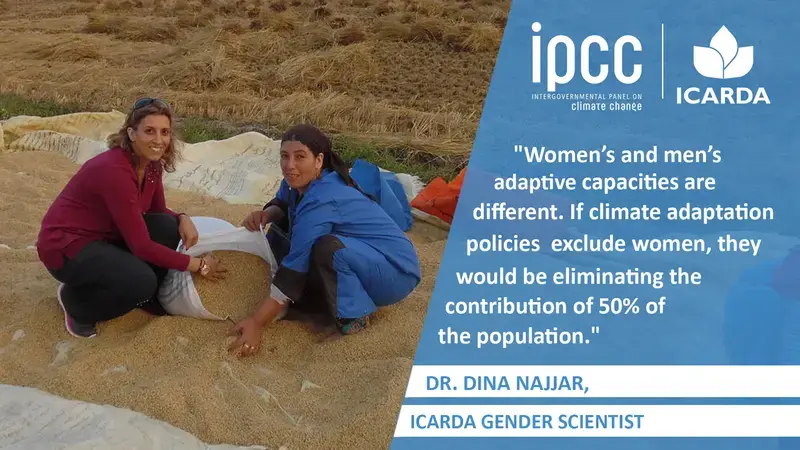GENDER SCIENTIST DR. DINA NAJJAR DISCUSSES DRYLANDS AND THE IPCC REPORT

In a mini-Q&A series published this week and the next, we spoke to several ICARDA scientists to get a better sense of what the future of climate change might look like across the drylands, and to discover how ICARDA is supporting dryland smallholders to adapt.
Today’s Q&A features Dr. Dina Najjar, a gender scientist at ICARDA. A socio-cultural anthropologist by training, she focuses on the link between gender equality and policies, agricultural technologies and delivery systems, rural employment and migration, adaption to climate change and productive assets, including access to land and ownership, in the Middle East and North Africa.
-----------
Dr. Dina Najjar: Female farmers’ roles are crucial for resilience: they tend to small ruminants and chicken, which are the very first resources to be sold in case of a shock, climate-induced or otherwise. In certain communities, these animals are called “cash” for that exact reason.
Women also contribute to households’ livelihoods diversity by manufacturing and selling products to local markets, such as cheese, harissa (chilli paste) and so on, which brings in substantial additional income, in the form of surplus to household's subsistence.
Finally, because of more frequent and protracted droughts, many men from the rural areas of Syria, Morocco and elsewhere in the drylands, out-migrate to cities or abroad, leaving the farm responsibilities in the hands of women. As a result, women must add this agricultural workload to their existing housework and family-related chores.
DN: They do experience climate change differently because of their distinct roles. But also, women’s work in irrigation and farming, roles traditionally prescribed to men, are often not officially recognized as such by extension systems or by local resource-use organizations, like agricultural cooperatives or water-users associations.
I looked at women and irrigation in Egypt for a study, and found that even though women are doing irrigation work, institutions still qualified it as ‘domestic water use.’ So women are often blindsided when it comes to their roles in agriculture that fit narrow, traditional roles.
In 2015, I wrote a piece on women’s and men's contributions to climate change adaptation in Upper Egypt. One of the adaptation mechanisms employed by women there was to plant cacti, for fruit production. Men would not go near that crop, which they referred to as a ‘lazy crop’ and eventually a ‘women’s crop,’ because they require minimal initial investment and maintenance. To men, cacti production was perceived as not demanding enough in terms of resources or tending to, and as such, not worth their attention.
Women planted cacti nonetheless, as cacti was in demand in nearby touristic and urban areas, but their efforts to create extra income was curtailed by the refusal from extension services to support them in pest management and fertilization practices.
DN: Water and irrigation remain less accessible to women than men. A lot of the water technology that exists, such as drip irrigation and pumps, is highly men-oriented and masculinized, and women often lack the financial resources to acquire them. In addition, they are also frowned upon when irrigating using traditional flood irrigation.
As a result, the land that women farm is often less likely to be irrigated than men’s. The other main challenges are the lack of recognition of women’s farm work, and their extremely limited access to land tenure. Although they do a large chunk of the agricultural labor, they mostly operate on lands they do not own.
Strengthening the right to land for women could really change this situation, because in times of crisis, what really stays is the land. All the other assets, like animals and other belongings, are the first to be sold and are highly liquefiable in times of crisis. Women in the dry regions have the lowest land ownership rates in the world.
DN: Women’s and men’s adaptive capacities are different. If climate adaptation policies exclude women, they would be eliminating the contribution of 50% of the population. By doing that, the country would lose in terms of GDP (Gross Domestic Product) points, crop yields, and healthy animals.
This would have serious implications for the nutritional security of the household members, particularly for children, as well as for national food security.
In the drylands, especially in places where irrigated and labor-intensive cash crops are cultivated, the system is predicated on women’s cheap labor. Not implementing gender sensitive climate adaptation would not only pose dignity and equality problems, but it will also mean that we would miss realizing the Sustainable Development Goal of decent work for all.
DN: Yes, without a doubt. Climate shock, or other crises such as COVID, have led to a rise in domestic disputes and violence against women. We found that in the same household, men and women had different perceptions of domestic conflict.
Therefore, it is crucial to collect data on men’s and women’s experiences to all sorts of shock in a disaggregated way, because crises are experienced by genders very differently.
